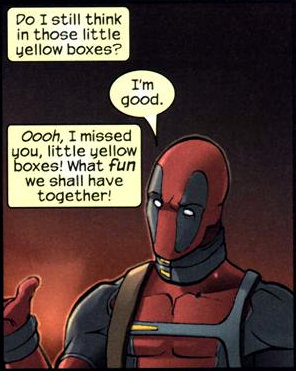 The ABCs of GMing
The ABCs of GMing
The ABCs of GMing is an ongoing series about the different skills and ideas needed to run a successful tabletop game.
Justification
As you may recall from the last segment, Improvisation‘s main point was when to stop your players from straying too far from the beaten path. This time, we talk about Justification and what I like to call “The Iron Fist of the GM”. While you want your players to have a fun time, it’s still your story, and you need to do everything you can to allow your players the freedom they want while keeping to the story you’ve laid out for them. There’s something to be said for being adaptive to your players, but it’s still your responsibility to give them a story everyone can enjoy. If they take the plot you’ve spent months working on and blow it all up in your face, then you’re not having fun anymore. And if your enjoyment of the game is sacrificed at the expense of your players’, it will reflect in the manner you run your game, and, ultimately, will lead to the demise of the story.
Since we don’t want that to happen, here’s a few ways to keep things moving along the way they should and how to justify those actions. A word of caution, though: it’s not enjoyable to constantly utilize these tips on your players. Rather, use them only when necessary and as needed to keep things on track.
Make It Seem Uninteresting

There are no alien scarecrows or ghosts of baseball players here. . .
This one is pretty straightforward. Say your PCs are traveling north along a road, and suddenly the druid wants to explore every inch of forest to the west, simply tell them there’s nothing of interest to be found. While this may seem like a great place for a break for some side action, you’re likely ready to throw your screen, dice, and verbal displeasure at your players by the fifth forest.
Simply take the seemingly small task and whittle it down to something as simple as “You don’t find anything.” If they insist on making rolls to do so, let them have one or two, and reward a great roll with something small (like a Tanglefoot Bag ). If your players begin to become a little irate at the prospect of getting nothing for exploring something, simply remind them that not every forest has some interesting treasure or animals hiding in the trees. Sometimes a forest is just a forest, and they definitely just wasted time exploring yet another one.
Make It Seem Impossible

Run Away!
Unless it’s a game system designed for characters to be killed (like, say, Paranoia), the last thing your players want to do is lose the character they’ve put so much effort into, especially outside of a climactic scene. So, when the level 2 Cleric thinks that it’s a really good idea to go after that Frost Giant, make sure they know that they are horrendously overpowered in the situation.
A good way to do this is to find a roll that allows them (or a fellow party member) to properly assess the situation. Let a sub-par success be an indicator that this is not a fight to be had. If they insist, emphasize their best attack to be nothing more than a scratch on their enemy. That should give them incentive to run from the situation. If all else fails, well, have them suffer the consequences. You don’t want to outright kill your player’s character, but a good brush with death should teach them a lesson about which challenges – like the Frost Giants – to leave alone. At least for now.
Discourage Ideas Too Outlandish During Character Creation

Tesla had some crazy ideas too. Your players are not Tesla.
One of my favorite all time game mechanics of any system is the feat/quality “Common Sense” from the Shadowrun universe. It’s a quality available during character creation solely meant for players newer to the system. Its function is to prevent characters from doing stupid things. This is, literally, the description of this feat:
- Any time such a character is about to do something the Game Master deems foolish, the Game Master must act as the proverbial inner voice of reason and warn the player: “Something tells you that’s a bad idea.”
How marvelously helpful for a GM! When I run a Shadowrun campaign, I always encourage at least one person to take this quality. It serves as the mental red flag when that character, or one of the other characters, starts crossing that fine line between idiot savant and downright moronic. When you don’t have the luxury of a built-in game mechanic for your players to avoid horrible mistakes, find similar ways within the system you are running to give characters this sixth sense where the GM is indirectly telling you that it’s probably a bad idea to continue with that course of action.
Break The Fourth Wall [As A Last Resort]
 Ideally, the last resort for any GM is to outright tell their players that they cannot do something. This is a situation that is ideally avoided, but sometimes you can’t help it. When I’m required to do so, my personal favorite schtick is saying, “Hey gang, this protagonist is named ‘Phillip Foresight’, and you should probably stop shooting at him.”
Ideally, the last resort for any GM is to outright tell their players that they cannot do something. This is a situation that is ideally avoided, but sometimes you can’t help it. When I’m required to do so, my personal favorite schtick is saying, “Hey gang, this protagonist is named ‘Phillip Foresight’, and you should probably stop shooting at him.”
Whatever your means of communicating the problem, sometimes it just comes down to temporarily halting the situation and informing your players to just stop what they’re doing. Your storytelling should be avoiding this rare and immersion-breaking situation, and yet sometimes things happen where you’re left with no alternative. Don’t feel ashamed. These things happen to everyone – veteran and novice GMs alike. You can at least take solace in knowing that you are not the only one that has been forced to resort to this level of intervention. Just hope it is a rare occurrence.
Next time, we’ll tackle the subject of Knowledge, and we’ll look at some of aspects of gaming a GM should know and learn that may not be so obvious. In the meantime, feel free to tell us all about those times when you’ve had to lay down the law to keep your players on track over on our social media pages!
Photo Credits: Grain Field by Wikimedia; Monty Python by Sony Pictures; Tesla by Getty Images; Deadpool by Wikia.
